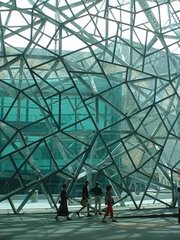Federation Square
|
|
Federation Square (or Fed Square) is the new public "heart" of the city of Melbourne, Australia. It is located on the southeast corner of the busy intersection of Flinders and Swanston Streets - the southern gateway to the central business district - and opposite Flinders Street Station and St Paul's Cathedral. It has since its opening on October 26, 2002, been both loved and despised by Melburnians, causing controversy not only for its unusual architecture, but also for the massive budget blowout and delays in construction.
The result of a design competition, Federation Square was designed by Don Bates and Peter Davidson of Lab Architecture Studio.
The complex is an seemingly-confusing mass of buildings in a rough U shape, surrounding a central ochre-coloured plaza which invokes images of the Outback, gently rising above street level.
The Square includes the Australian Centre for the Moving Image (ACMI), the Ian Potter Centre: NGV Australia, the BMW Edge auditorium, the local SBS (Special Broadcasting Service) TV headquarters, and a number of cafès and restaurants, including the TransPort pub.
| Contents [hide] |
Ian Potter Centre: NGV Australia
The Ian Potter Centre houses the Australian part of the art collection of the National Gallery of Victoria (NGV), and is located at Federation Square (international works are displayed at the NGV International on St Kilda Rd). There are over 20,000 Australian artworks, including paintings, sculpture, photography, fashion and textiles, and the collection is one of the oldest and most well-known in the country.
Well-known works at the Ian Potter Centre include Frederick McCubbin's Pioneers (1904) and Tom Roberts' Shearing of the Rams (1890). The Heidelberg School is also represented by works from Sidney Nolan, John Perceval, Margaret Preston and Fred Williams.
Indigenous art includes works by William Barak and Emily Kngwarreye.
Australian Centre for the Moving Image
The Australian Centre for the Moving Image, or ACMI, is the worlds first museum dedicated to the moving image in all its forms (The Museum of the Moving Image in New York is only dedicated to film). The two cinemas are equipped to play every film, video and digital video format, with very high quality attention to acoustics. The screen gallery, built along the entire length of what was previously a train station platform, is a subterraenean gallery for experimentation with the moving image. Video art, installations, interactives, sound art and net art are all regularly exhibited in this space. Additional venues within ACMI allow computer-based public education, and other interactive presentations.
In 2003, ACMI commissioned SelectParks to produce an interactive game-based, site specific installation called AcmiPark. AcmiPark replicates and abstracts the real world architecture of Federation Square. It also houses highly innovative mechanisms for interactive, multiplayer sound and musical composition.
The Labyrinth
The so-called "Labyrinth" is a passive cooling system sandwiched above the railway lines and below the middle of the square. The concrete structure consists of 1.2 km of interlocking, honeycombed walls. It covers 160 m2. The walls have a zig-zag profile to maximize their surface area, and are spaced 60 cm apart.
During summer, cold air is pumped in the combed space, cooling down the concrete, while heat absorbed during the day is pumped out. The following day, cold air is pumped from the Labyrinth out into the Atrium through floor vents. This process can keep the Atrium up to 12 °C cooler than outside. This is comparable to conventional air conditioning, but using one-tenth the energy and producing one-tenth the carbon dioxide.
During winter, the process is reversed, whereby warm daytime air stored in the Labyrinth overnight, to be pumped back into the Atrium during the day.
The system can also partly cool the ACMI building when the power is not required by the Atrium.
Birrarung Marr
Behind the square is the equally new riverside park, Birrarung Marr.

